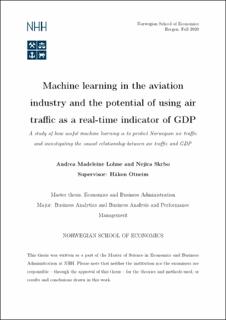Machine learning in the aviation industry and the potential of using air traffic as a real-time indicator of GDP : a study of how useful machine learning is to predict Norwegian air traffic and investigating the causal relationship between air traffic and GDP
Master thesis
Permanent lenke
https://hdl.handle.net/11250/2735120Utgivelsesdato
2020Metadata
Vis full innførselSamlinger
- Master Thesis [4372]
Sammendrag
Travel by air is an essential part of both the Norwegian society and its infrastructure,
where Norway has one of the highest number of flights per capita in Europe. Nonetheless,
the aviation industry is characterized by high uncertainty, with the Covid-19 pandemic
being the most recent one.
This thesis has sought to investigate the use of machine learning in the Norwegian aviation
industry and how the number of air passengers potentially can be used as a real-time
indicator of GDP. Therefore, the thesis has been divided into two parts. The first part has
aimed to use machine learning to predict the number of domestic and total passengers per
capita in Norway. More precisely, we applied the methods OLS, elastic net, and random
forest. The purpose of the second part has been to investigate the causal relationship
between air passengers and GDP by conducting a strict linear Granger causality test. We
particularly questioned whether air passengers could be used as a real-time indicator of
GDP.
The findings suggest that machine learning is applicable for predicting the number of air
passengers per capita in Norway, where elastic net yield the best results. In relation to
the second part of the thesis, the findings reveal a causal relationship running from air
passengers to GDP. Consequently, we find that there is a potential of using the number of
air passengers as a real-time indicator of GDP in Norway.
Keywords – Machine learning, the Norwegian aviation industry, economic growth,
causality, real-time indicators
